 A murder by any other name would kill as dead. 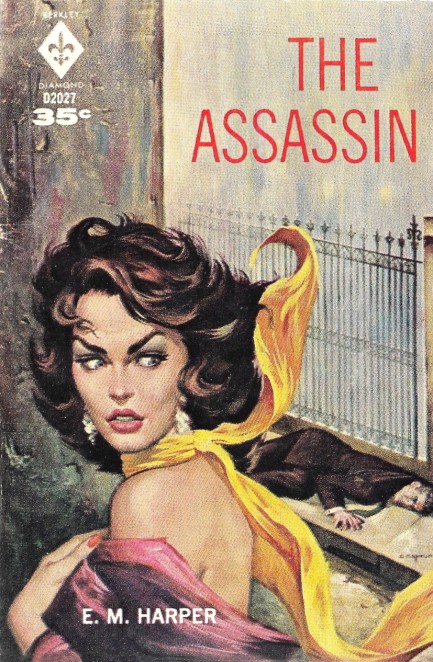
This is a rather pretty cover painted by Charles Copeland for E.M. Harper's 1960 novel The Assassin, the story of Alec Jordan, who's spared the guillotine in an Algerian prison but must repay the shadowy government operatives who freed him by murdering an Arab political figure. We've seen convicts turned into assassins a couple times in vintage literature. What sets this story apart is its many flashbacks to Jordan's youth, from the time he was witness to his moonshiner father's killing by cops, to being sprung from reform school to play high school football (seems someone always wants to put his skills to use), to his various war experiences.
The story begins in Paris, from which Jordan pursues his target to London and Vienna, world weary, haunted by the past, and hounded by the people who are operating him. There's, unsurprisingly, the requisite woman-from-his-past for whom he still has feelings—a beauty named Renée who married an Austrian count while Jordan was hors de combat. Conveniently, she's now a widow, but is reclaiming the past an option for Jordan? To survive but lose your soul, to resist corruption but be killed, to find redemption in love. You've read it before, and though Harper breaks no new ground plotwise, he wrote a contemplative iteration of the story that offers some enjoyment.
 Mitchum packs everything he needs for traveling except his sleuthing hat. 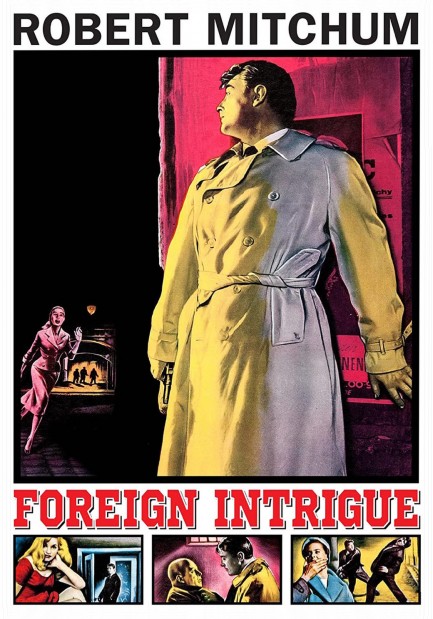
This beautiful poster for the Robert Mitchum thriller Foreign Intrigue is yet another framable delight from the golden age of Hollywood. Wikipedia calls this movie a film noir, but genre designations are often wrong there and on IMDB. This is actually a spy movie, often light in tone, sort of like the later films Charade and Arabesque. Mitchum is an American in Paris working as a press agent for a reclusive one percenter. When his employer dies of a heart attack, Mitchum comes to believe there was more to the death than a blown ventricle. He follows a trail of clues from the French Riviera to Vienna and Stockholm, which is where the foreign part of Foreign Intrigue comes in. The intrigue part? Well, that never fully develops. In fact, the movie falls back on the cliché of having the villains explain their plot to the protagonist. It has to do with money, blackmail, traitors, and Hitler. Trust us, it's not as interesting as it sounds. Compounding the narrative problems is a dopey soundtrack and a Mitchum who's short on charm here. The flirtations between him and Swedish love interest Ingrid Thulin are solid wood. She went on to win Best Actress at the 1958 Cannes Film Festival, which goes to show that half of acting is screenwriting. Are there any saving graces to Foreign Intrigue? Of course. It's well shot, atmospheric, cast with international actors and their wonderful accents, and is a nice travelogue, encompassing Mediterranean villas, Vienna backstreets, and Swedish lakes, all in lush Eastmancolor. And Mitchum is watchable even in a film that mostly wastes his considerable star power. Intrigued? Then go for it. Foreign Intrigue premiered today in 1956. 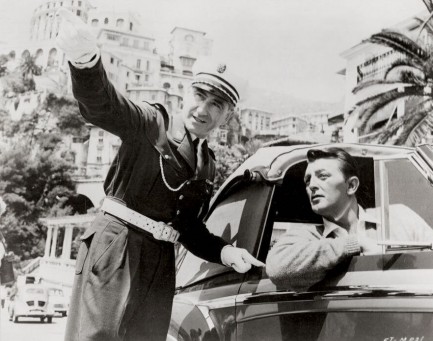 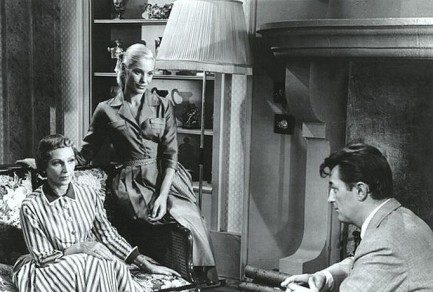 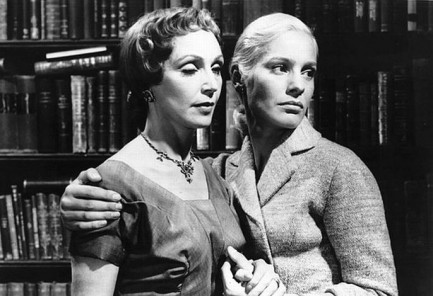 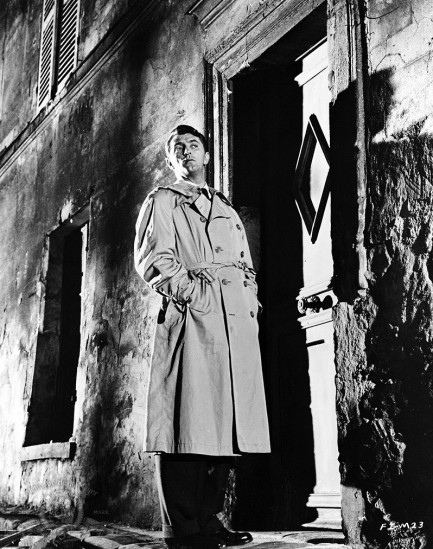 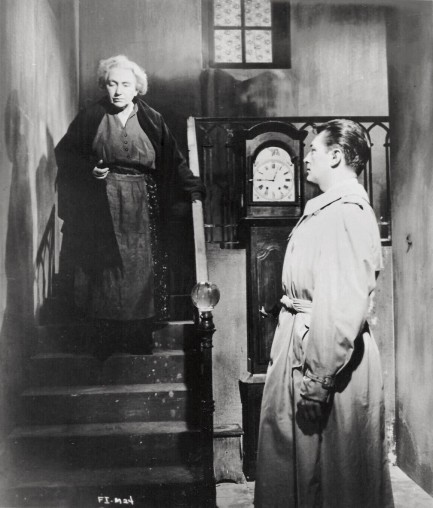 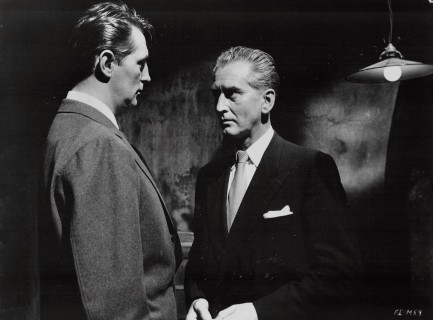 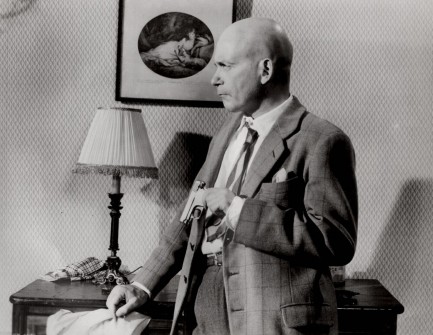 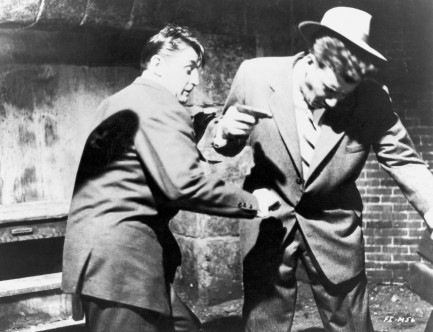 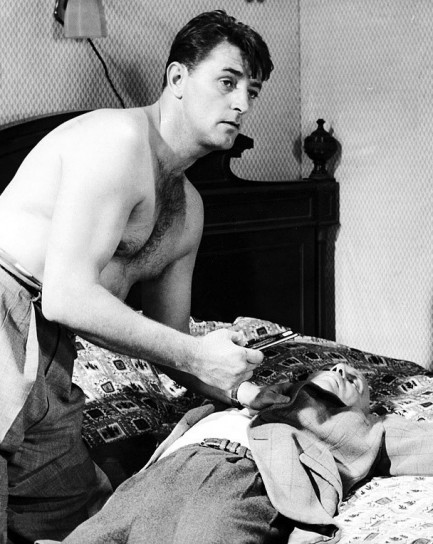 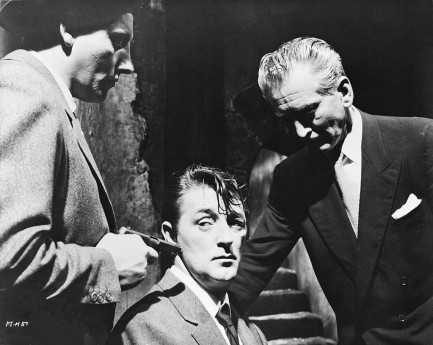 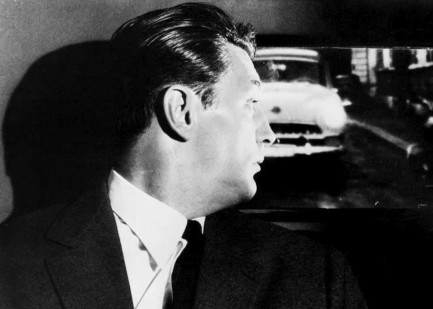 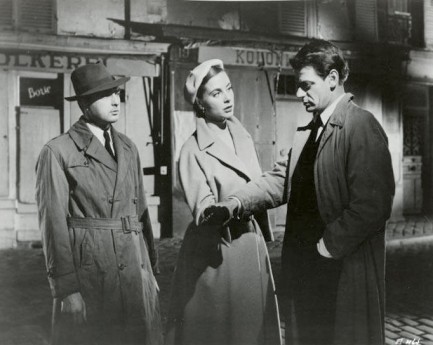 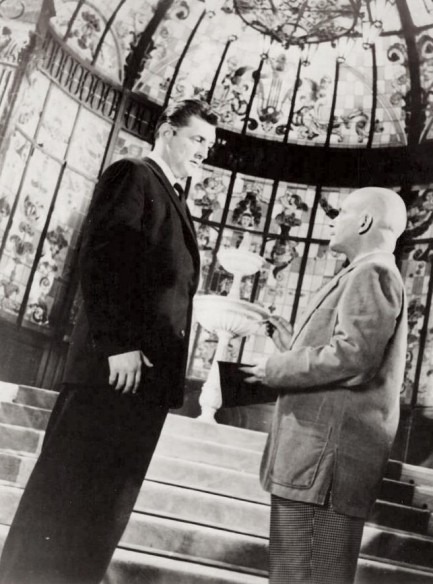 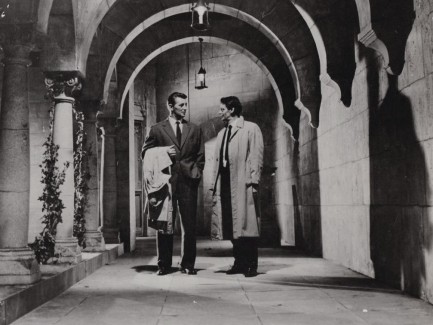 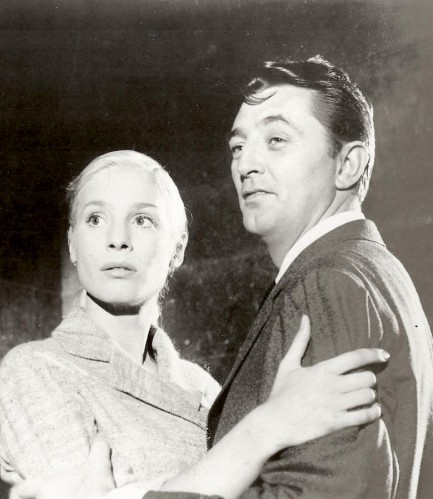 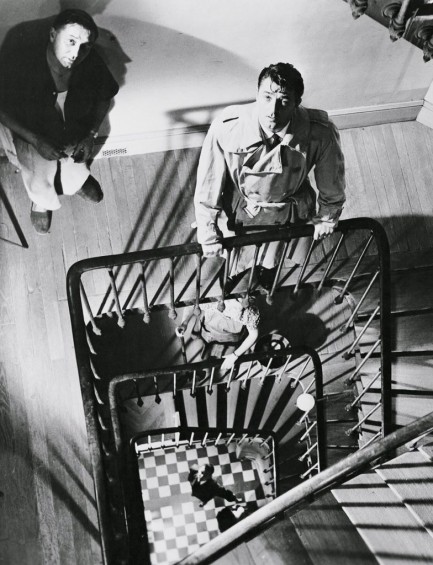
 Is there anything sweeter than a beautiful movie palace? 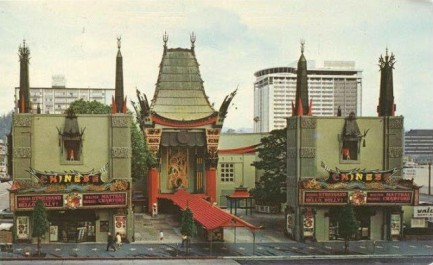
You probably recognize Grauman's Chinese Theatre, in Los Angeles. These days it's called TCL Chinese Theatre, because it's owned and operated by TCL Corporation—based in China, ironically. Since we write so often about movies we thought it appropriate to discuss the beautiful buildings in which the films were exhibited. Back in the day these were usually purpose-built structures, though some did split duty for stage productions and concerts. While many of these old palaces survive, nearly all surviving vintage cinemas in the U.S. were under threat at some point. Generally, if they hadn't been given historic protection they wouldn't be upright today.
Other times, if a city was poor, real estate costs didn't rise and old buildings stood unthreatened, usually idle. This happened often in the American midwest, where movie houses were neglected for decades before some were resurrected amid downtown revitalizations. It sometimes happens in Latin America too, although occasionally the formula fails. For example, Cartagena's majestic and oft photographed landmark Teatro Colón, located in the historic section of Colombia's most popular coastal tourist city, was torn down fewer than six months ago to make way for a Four Seasons Hotel.
Some of the cinemas below are well known treasures, while others are more unassuming places. But even those lesser known cinemas show how much thought and work was put into making moviegoing a special experience. The last photo, which shows the Butterfly Theatre in Milwaukee, exemplifies that idea. The façade is distinguished by a terra cotta butterfly sculpture adorned with light bulbs. As you might guess, many of the most beautiful large cinemas were in Los Angeles, which means that city is well represented in the collection. Enjoy.
 Paramount Theatre, Oakland (operational). Paramount Theatre, Oakland (operational).
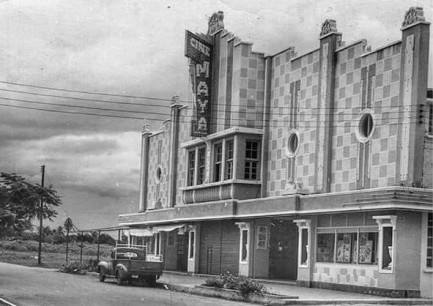 Cine Maya, Mérida (demolished). Cine Maya, Mérida (demolished).
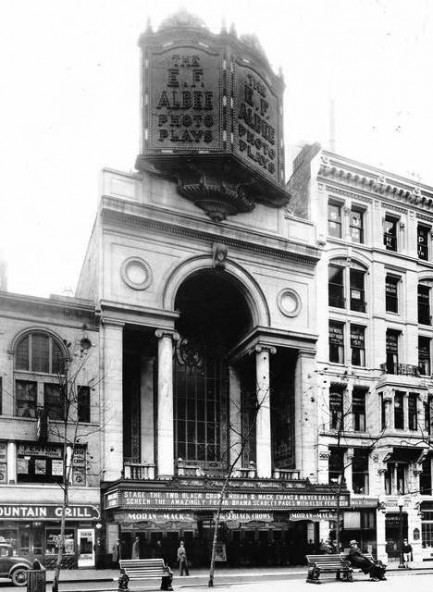 The Albee Cinema, Cincinnati (demolished) The Albee Cinema, Cincinnati (demolished)
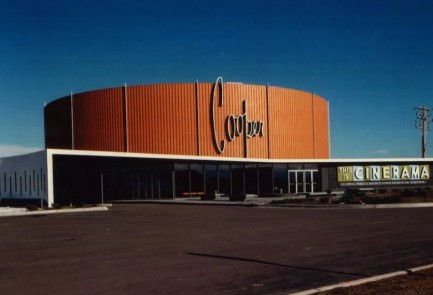 Cooper Theatre, Denver (demolished). Cooper Theatre, Denver (demolished).
 Paras Cinema, Jaipur (operational). Paras Cinema, Jaipur (operational).
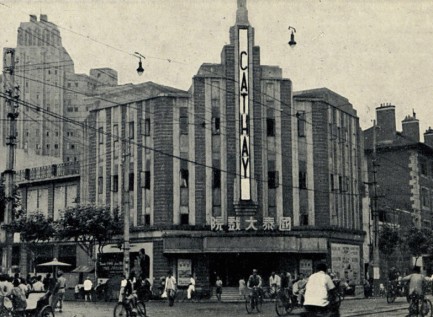 Cathay Cinema, Shanghai (operational). Cathay Cinema, Shanghai (operational).
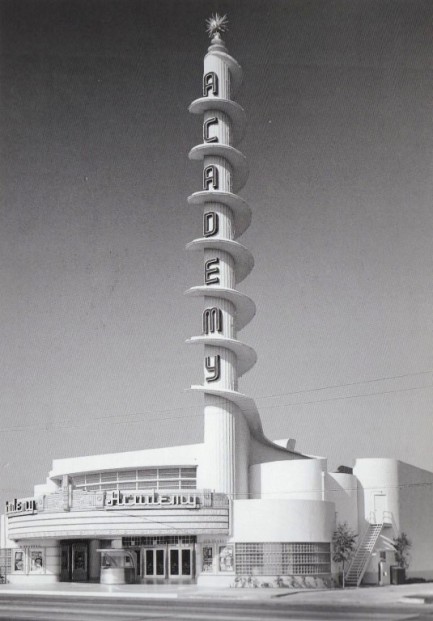 Academy Theatre, Los Angeles (operational). Academy Theatre, Los Angeles (operational).
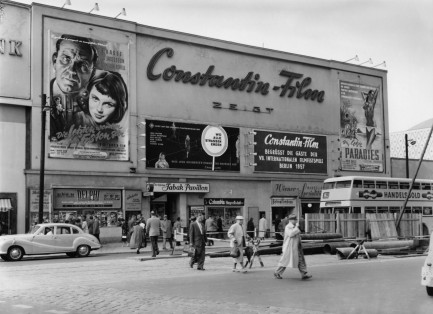 Charlottenburg Filmwerbung, Berlin (demolished). Charlottenburg Filmwerbung, Berlin (demolished).
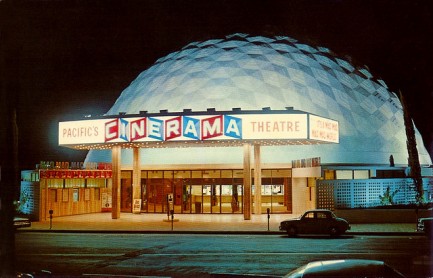 Pacific's Cinerama Theatre, Los Angeles (operational). Pacific's Cinerama Theatre, Los Angeles (operational).
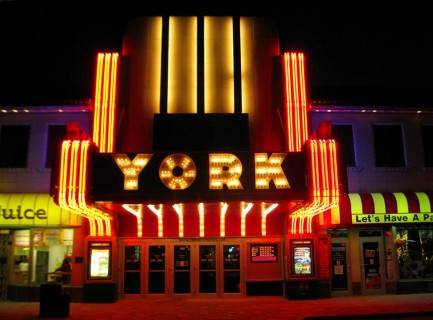 York Theatre, Elmhurst (operational). York Theatre, Elmhurst (operational).
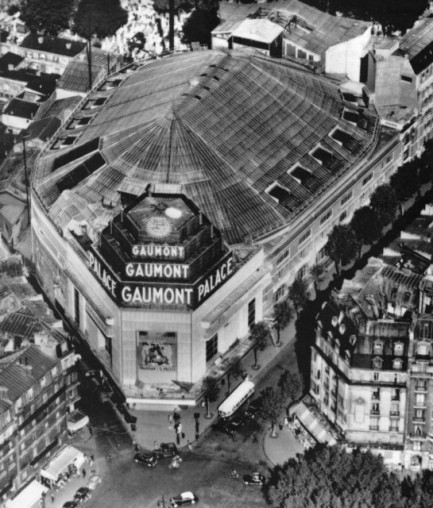 La Gaumont-Palace, Paris (demolished). La Gaumont-Palace, Paris (demolished).
 Essoldo Cinema, Newcastle (demolished). Essoldo Cinema, Newcastle (demolished).
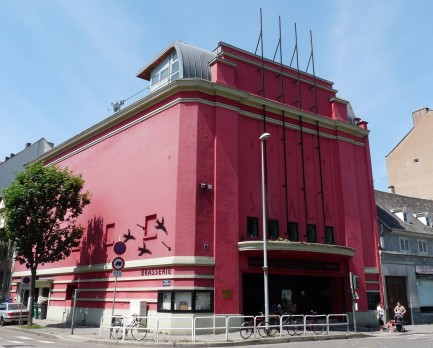 Théâtre Scala, Strasbourg (operational). Théâtre Scala, Strasbourg (operational).
 Teatro Colón, Cartagena (demolished in 2018). Teatro Colón, Cartagena (demolished in 2018).
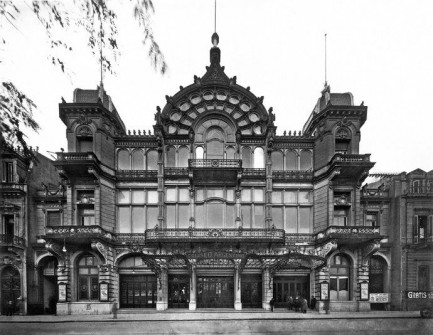 Teatro Coliseo Argentino, Buenos Aires (demolished). Teatro Coliseo Argentino, Buenos Aires (demolished).
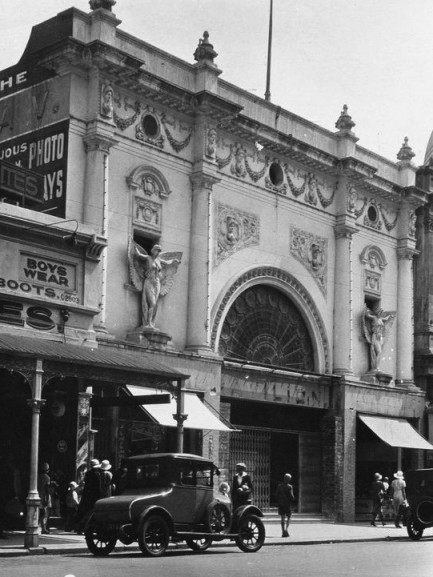 Pavilion Theater, Adelaide (demolished). Pavilion Theater, Adelaide (demolished).
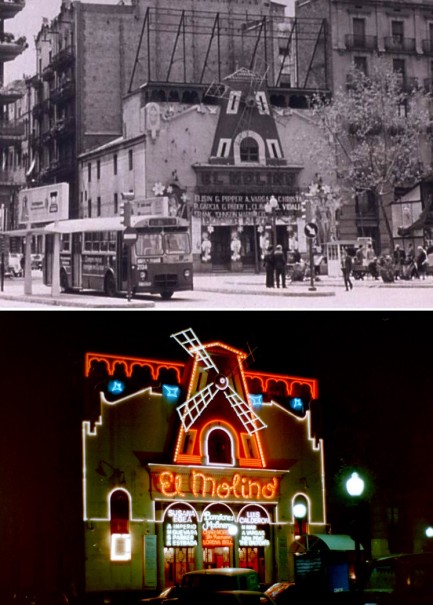 El Molino Teatro, Barcelona (operational). El Molino Teatro, Barcelona (operational).
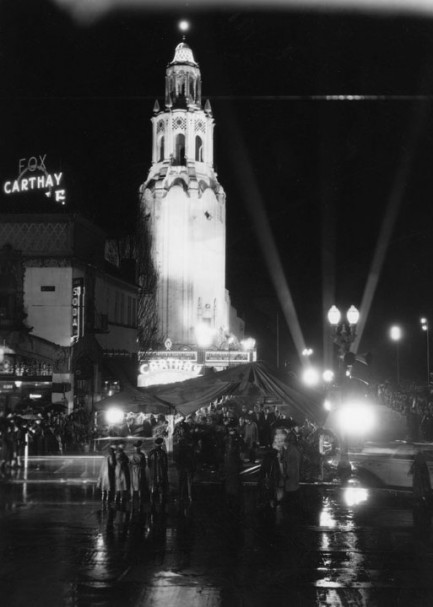 Fox Carthay Theatre, Los Angeles (demolished). Fox Carthay Theatre, Los Angeles (demolished).
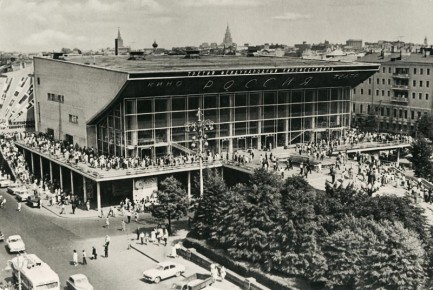 Kino Rossiya Teatr, Moscow (operational). Kino Rossiya Teatr, Moscow (operational).
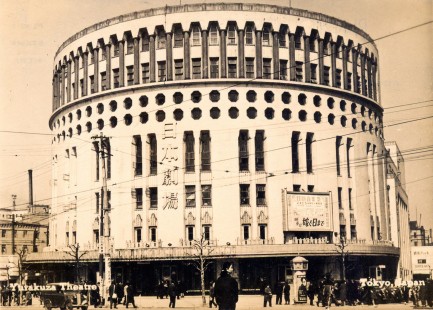 Nippon Gekijo, aka Nichigeki, Tokyo (demolished). Nippon Gekijo, aka Nichigeki, Tokyo (demolished).
 Cine Impala, Namibe (operational). Cine Impala, Namibe (operational).
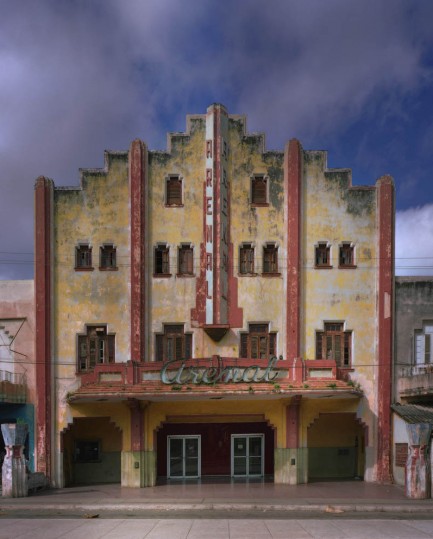 Cine Arenal, Havana (operational). Cine Arenal, Havana (operational).
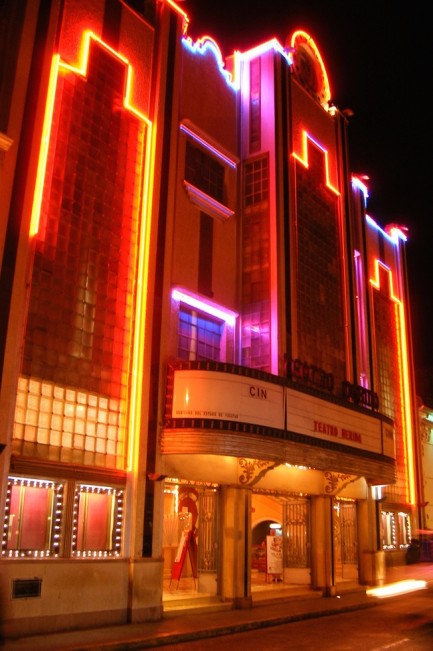 Teatro Mérida, Mérida (operational, renamed Teatro Armando Manzanero). Teatro Mérida, Mérida (operational, renamed Teatro Armando Manzanero).
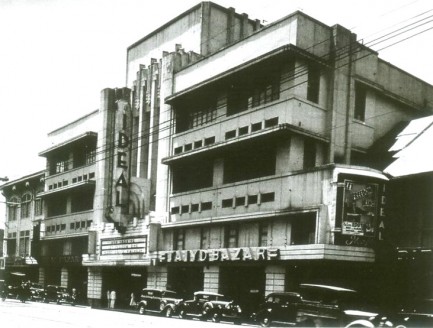 Ideal Theater, Manila (demolished). Ideal Theater, Manila (demolished).
 Odeon Cinema, London (semi-demolished, converted to apartments). Odeon Cinema, London (semi-demolished, converted to apartments).
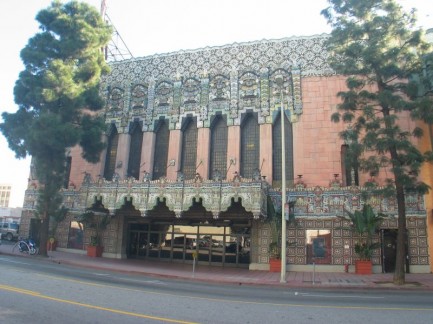 Mayan Theatre, Los Angeles (operational). Mayan Theatre, Los Angeles (operational).
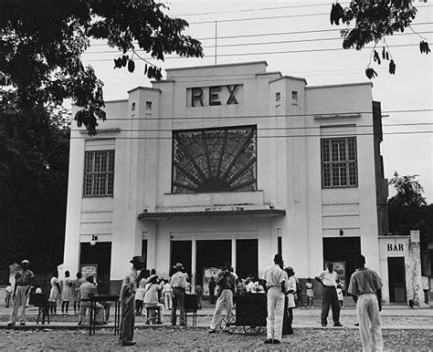 Rex Cinema, Port au Prince (being restored). Rex Cinema, Port au Prince (being restored).
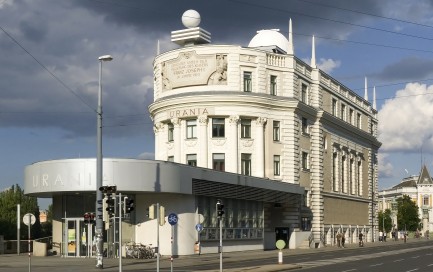 Urania Kino, Vienna (operational). Urania Kino, Vienna (operational).
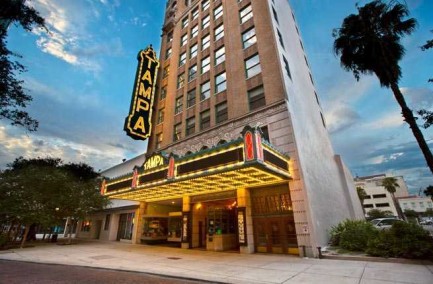 Tampa Theatre, Tampa (operational). Tampa Theatre, Tampa (operational).
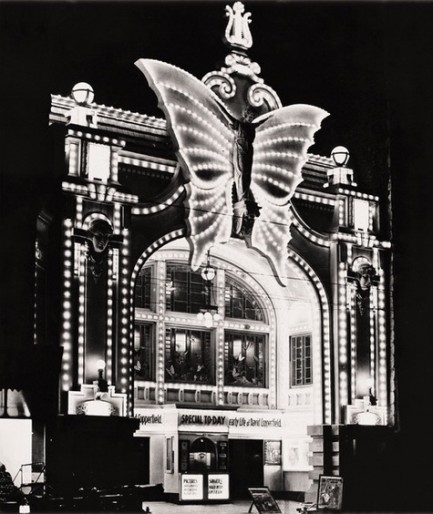 The Butterfly Theater, Milwaukee (demolished). The Butterfly Theater, Milwaukee (demolished).
 Rumors of her demise were greatly exaggerated. 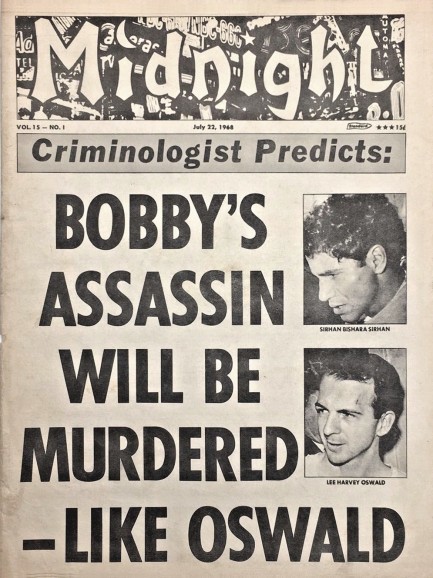 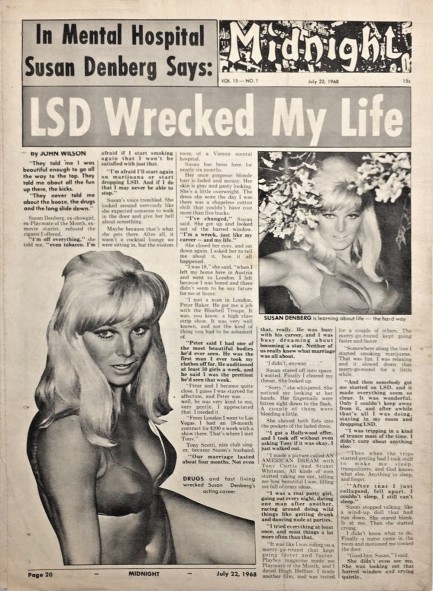
We've featured the Canadian tabloid Midnight numerous times. This one appeared on newsstands today in 1968. On the cover readers get a headline referring to Robert F. Kennedy, who had been assassinated the previous month. His name is accompanied by a prediction that his killer, Jordanian nationalist Sirhan Sirhan, would in turn be assassinated. It wasn't an outrageous prediction—during the late 1960s newsworthy figures were being dropped like three foot putts. Sirhan was never murdered, though, and he's still around today, languishing at Richard J. Donovan Correctional Facility in San Diego County, California.
Sirhan is an interesting character, but it's the story on Susan Denberg we're interested in today. Denberg, née Dietlinde Zechner, is a German born beauty who became a Playboy Playmate of the Year and screen actress, was a desired Hollywood party girl who, 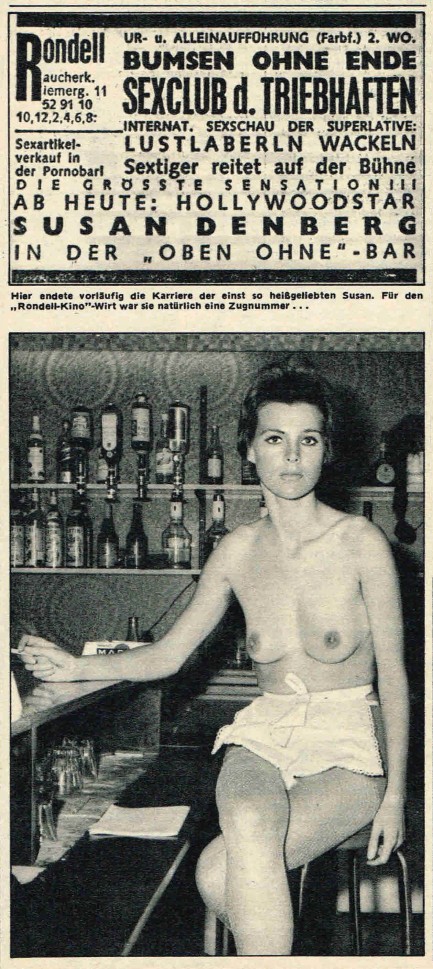 acording to sources, had relationships with Hugh Hefner and Jim Brown. She was generally regarded as one of the major sex symbols of her time, but she also became a drug addict. After making the 1968 film Frankenstein Created Woman Denberg returned to Europe and shunned the movie business. In fact, she kept such a low profile that for years sources incorrectly reported that she had died. acording to sources, had relationships with Hugh Hefner and Jim Brown. She was generally regarded as one of the major sex symbols of her time, but she also became a drug addict. After making the 1968 film Frankenstein Created Woman Denberg returned to Europe and shunned the movie business. In fact, she kept such a low profile that for years sources incorrectly reported that she had died.
Midnight journo John Wilson claims to have visited Denberg in a Vienna mental hospital near the beginning of her self-imposed exile, and his article is basically a recounting of his chat with her. He describes her depressing surroundings and portrays her as a sort of broken bird, quoting her as saying, “I was a real party girl, going out every night, dating one man after another, running around doing wild things like getting drunk and dancing nude at parties. And then someone got me started on LSD and it made everything seem so clear. It was wonderful. Only I couldn't keep away from it, and after a while that was all I was doing, staying in my room and dropping LSD.”
In 1971 Denberg had a child, and by 1972 was making her living on the nudie bar circuit, working as a topless server at the adult cinema Rondell in Vienna, and later dancing fully nude at another Vienna nightspot called Renz. She also worked elsewhere in Europe, including Geneva, where in 1974 she tried to commit suicide by swallowing a reported 200 sleeping pills, an amount that surely would have been fatal had she not been quickly found and sped to a hospital. In 1976 she became a mother again and retired from nude dancing. Today she lives quietly in Vienna.
Denberg's story is filled with twists and turns, and yet it isn't unique in a place like Hollywood. As she makes clear, once enough power brokers, modeling agents, and studio types tell a woman she's special she's probably going to believe them, but once she believes them it's hard for her to keep her head on straight. She sums up her journey to Midnight, “They told me I was beautiful enough to go all the way to the top. They told me about all the fun up there, the kicks. They never told me about the booze and the drugs, the long slide down.” 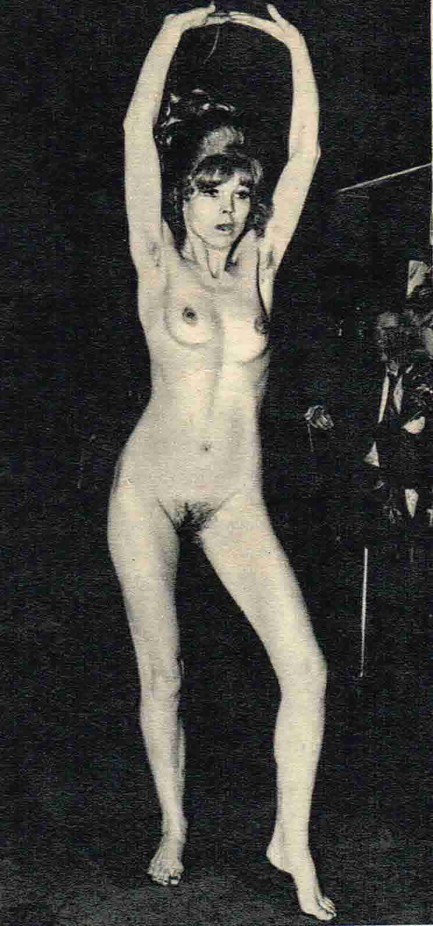 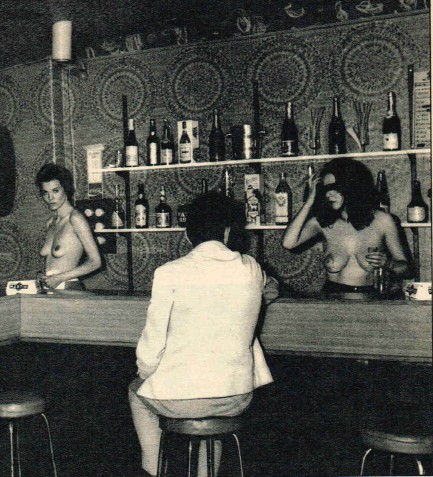
 Vice and virtue in Vienna. 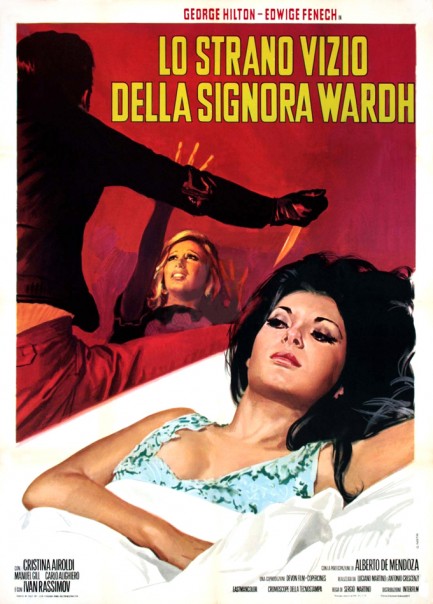
So, quite by coincidence there’s another movie we watched recently that also premiered today, though thirty years later than The Shanghai Gesture (see below). The movie is Lo strano vizio della Signora Wardh, which would translate as “The Strange Vice of Mrs. Wardh,” but was released in the U.S. as Blade of the Ripper. This flick is considered one of the best gialli ever made, and it’s tough to argue the point. It’s intricate, absorbing, unpredictable, colorful, and shot in an array of amazing external locations and inside one of the greatest mid-century modern apartments ever conceived. It also has Edwige Fenech, whose gifts are well known. Taking place mainly in Vienna and climaxing in Sitges, Spain (which happens to be one of our favorite towns in Europe)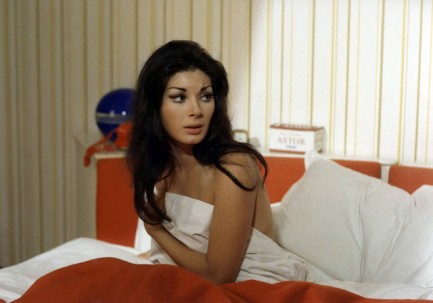   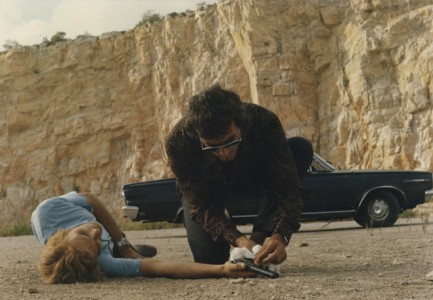 Signora Wardh is a tale of obssession and infidelity wrapped in a murder mystery. Mrs. Wardh does indeed have a strange vice, but that’s just window dressing. It’s her that’s being hunted throughout the movie—either by a serial killer, a demented ex-lover, or both. Or neither. They say that the only way to keep a secret is if no more than two people know it and one of them is dead. But the only way to commit murder is if the killer has an iron clad alibi, and for that he often needs help. Rule one conflicts with rule two, and that’s the fun of Signora Wardh. Above you see a rare and wonderful Italian promo poster painted by Giuliano Nistri, the younger brother of equally talented Enzo Nistri. We'll get back to both Nistri brothers a little later. Lo strano vizio della Signora Wardh opened in Italy today in 1971. Signora Wardh is a tale of obssession and infidelity wrapped in a murder mystery. Mrs. Wardh does indeed have a strange vice, but that’s just window dressing. It’s her that’s being hunted throughout the movie—either by a serial killer, a demented ex-lover, or both. Or neither. They say that the only way to keep a secret is if no more than two people know it and one of them is dead. But the only way to commit murder is if the killer has an iron clad alibi, and for that he often needs help. Rule one conflicts with rule two, and that’s the fun of Signora Wardh. Above you see a rare and wonderful Italian promo poster painted by Giuliano Nistri, the younger brother of equally talented Enzo Nistri. We'll get back to both Nistri brothers a little later. Lo strano vizio della Signora Wardh opened in Italy today in 1971.
 
 The Third Man is a stiff drink, with a twist of Lime. 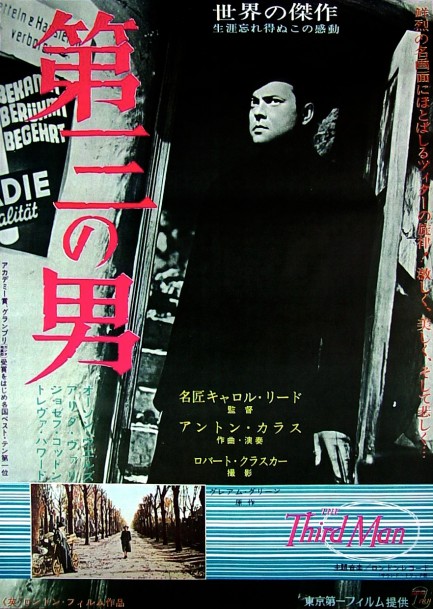 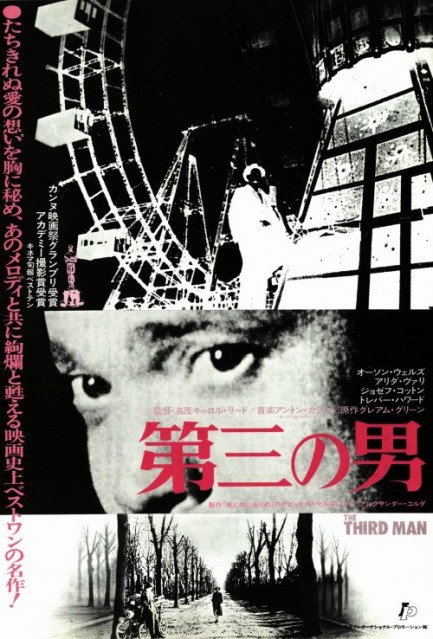
The 1949 film noir The Third Man is a best-case-scenario of what can happen when great talents collaborate. Carol Reed directs, Orson Welles, Alida Valli and Joseph Cotten act from a screenplay penned by master storyteller Graham Greene, and the cinematographer is Robert Krasker. Krasker won an Academy Award for his work here, and when you see the velvety blacks and knifing shadows of his nighttime set-ups, as well as the famed scenes shot in the cavernous Vienna sewers and bombed out quadrants of the city center, you’ll understand why. The story involves a pulp writer named Holly Martins who arrives in a partitioned post-war Vienna only to find that his friend Harry Lime is dead, run down by a truck. When Martins learns that the police are disinterested in the circumstances of Lime’s demise, he decides to do what one of his pulp characters would do—take matters into his own hands. But nothing adds up. He learns that Lime died instantly, or survived long enough to utter a few last words. He finds that Lime was a racketeer, or possibly not. And he discovers that two men were present when Lime died—or possibly three. That third man seems to be the key to the mystery, but he proves to be damnably elusive. We can’t recommend this film highly enough. Above you see a pair of rare Japanese posters from The Third Man’s premiere in Tokyo today in 1952.
 You can run from your past, but you can’t hide. 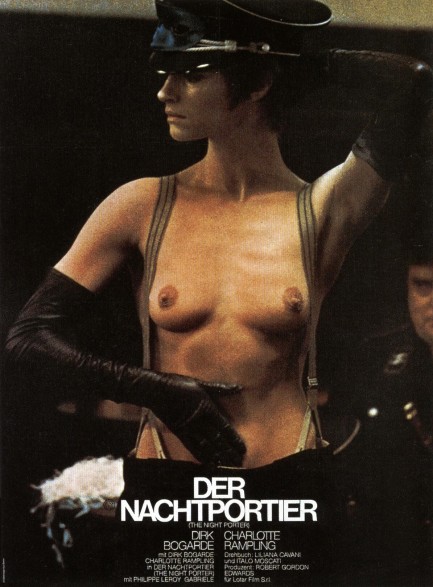
Liliana Cavani’s controversial drama Il portiere di notte, aka The Night Porter, is a landmark of Italian cinema, and another of those seventies films that could never be made today. It involves the sado-masochistic relationship between a concentration camp survivor, played by Charlotte Rampling, and a former camp officer, played by Dirk Bogarde. The camp is eventually liberated, but the Nazi manages to escape the Allies. Postwar he builds a normal-seeming life but must carefully hide his former identity. Meanwhile, the woman builds a normal-seeming marriage, but conceals her psychological scars. In Vienna years later, the woman is shocked to encounter the Nazi again, and soon their destructive codependency is rekindled. The amazing promo poster above uses a frame from the movie’s pivotal scene, a flashback in which Rampling performs a striptease wearing an SS uniform, after which her captor rewards her á la Salomé with the head of a prisoner who has been tormenting her. Il portiere di notte is dark, slow, and deadly serious, but for the true film buff it’s probably a must-see. It was generally well-reviewed upon release, but there were also slams from a few major critics. In the end, you’ll have to make your own decision. Il portiere di notte premiered in West Germany yesterday, 1974.
 Magical creatures do exist. 
Above is a weathered looking photo of Austrian actress and singer Elfie Mayerhofer. She appeared in about twenty motion pictures, including 1939's The Curtain Falls and 1952's Verlorene Melodie, aka Vanished Melody, and as a singer was nicknamed the Viennese Nightingale. Wanna hear her voice? Check here. Also, you're probably wondering if Elfie was her real name. Based on what we can discern, it seems to have been. That's pretty cool.
 East German anti-Nazi drama is considered a classic. 
Here’s a nice Romanian promo poster for the anti-Nazi drama Lissy, starring Sonia Sutter, and based on a novel by Franz Carl Weiskopf. The film was made in East Germany, and against all odds, earned an American release and brought Sutter a measure of critical acclaim. She eventually acted in more than twenty films, but is better remembered for her distinguished four-decade career at the famous Burgtheater in Vienna. Lissy premiered in East Berlin yesterday in 1957.
|
 |

The headlines that mattered yesteryear.
1945—Mussolini Is Arrested
Italian dictator Benito Mussolini, his mistress Clara Petacci, and fifteen supporters are arrested by Italian partisans in Dongo, Italy while attempting to escape the region in the wake of the collapse of Mussolini's fascist government. The next day, Mussolini and his mistress are both executed, along with most of the members of their group. Their bodies are then trucked to Milan where they are hung upside down on meathooks from the roof of a gas station, then spat upon and stoned until they are unrecognizable. 1933—The Gestapo Is Formed
The Geheime Staatspolizei, aka Gestapo, the official secret police force of Nazi Germany, is established. It begins under the administration of SS leader Heinrich Himmler in his position as Chief of German Police, but by 1939 is administered by the Reichssicherheitshauptamt, or Reich Main Security Office, and is a feared entity in every corner of Germany and beyond. 1937—Guernica Is Bombed
In Spain during the Spanish Civil War, the Basque town of Guernica is bombed by the German Luftwaffe, resulting in widespread destruction and casualties. The Basque government reports 1,654 people killed, while later research suggests far fewer deaths, but regardless, Guernica is viewed as an example of terror bombing and other countries learn that Nazi Germany is committed to that tactic. The bombing also becomes inspiration for Pablo Picasso, resulting in a protest painting that is not only his most famous work, but one the most important pieces of art ever produced. 1939—Batman Debuts
In Detective Comics #27, DC Comics publishes its second major superhero, Batman, who becomes one of the most popular comic book characters of all time, and then a popular camp television series starring Adam West, and lastly a multi-million dollar movie franchise starring Michael Keaton, then George Clooney, and finally Christian Bale. 1953—Crick and Watson Publish DNA Results
British scientists James D Watson and Francis Crick publish an article detailing their discovery of the existence and structure of deoxyribonucleic acid, or DNA, in Nature magazine. Their findings answer one of the oldest and most fundamental questions of biology, that of how living things reproduce themselves.
|

|
|

It's easy. We have an uploader that makes it a snap. Use it to submit your art, text, header, and subhead. Your post can be funny, serious, or anything in between, as long as it's vintage pulp. You'll get a byline and experience the fleeting pride of free authorship. We'll edit your post for typos, but the rest is up to you. Click here to give us your best shot.

|
|






















 Paramount Theatre, Oakland (operational).
Paramount Theatre, Oakland (operational). Cine Maya, Mérida (demolished).
Cine Maya, Mérida (demolished). The Albee Cinema, Cincinnati (demolished)
The Albee Cinema, Cincinnati (demolished) Cooper Theatre, Denver (demolished).
Cooper Theatre, Denver (demolished). Paras Cinema, Jaipur (operational).
Paras Cinema, Jaipur (operational). Cathay Cinema, Shanghai (operational).
Cathay Cinema, Shanghai (operational). Academy Theatre, Los Angeles (operational).
Academy Theatre, Los Angeles (operational). Charlottenburg Filmwerbung, Berlin (demolished).
Charlottenburg Filmwerbung, Berlin (demolished). Pacific's Cinerama Theatre, Los Angeles (operational).
Pacific's Cinerama Theatre, Los Angeles (operational). York Theatre, Elmhurst (operational).
York Theatre, Elmhurst (operational). La Gaumont-Palace, Paris (demolished).
La Gaumont-Palace, Paris (demolished). Essoldo Cinema, Newcastle (demolished).
Essoldo Cinema, Newcastle (demolished). Théâtre Scala, Strasbourg (operational).
Théâtre Scala, Strasbourg (operational). Teatro Colón, Cartagena (demolished in 2018).
Teatro Colón, Cartagena (demolished in 2018). Teatro Coliseo Argentino, Buenos Aires (demolished).
Teatro Coliseo Argentino, Buenos Aires (demolished). Pavilion Theater, Adelaide (demolished).
Pavilion Theater, Adelaide (demolished). El Molino Teatro, Barcelona (operational).
El Molino Teatro, Barcelona (operational). Fox Carthay Theatre, Los Angeles (demolished).
Fox Carthay Theatre, Los Angeles (demolished). Kino Rossiya Teatr, Moscow (operational).
Kino Rossiya Teatr, Moscow (operational). Nippon Gekijo, aka Nichigeki, Tokyo (demolished).
Nippon Gekijo, aka Nichigeki, Tokyo (demolished). Cine Impala, Namibe (operational).
Cine Impala, Namibe (operational). Cine Arenal, Havana (operational).
Cine Arenal, Havana (operational). Teatro Mérida, Mérida (operational, renamed Teatro Armando Manzanero).
Teatro Mérida, Mérida (operational, renamed Teatro Armando Manzanero). Ideal Theater, Manila (demolished).
Ideal Theater, Manila (demolished). Odeon Cinema, London (semi-demolished, converted to apartments).
Odeon Cinema, London (semi-demolished, converted to apartments). Mayan Theatre, Los Angeles (operational).
Mayan Theatre, Los Angeles (operational). Rex Cinema, Port au Prince (being restored).
Rex Cinema, Port au Prince (being restored). Urania Kino, Vienna (operational).
Urania Kino, Vienna (operational). Tampa Theatre, Tampa (operational).
Tampa Theatre, Tampa (operational). The Butterfly Theater, Milwaukee (demolished).
The Butterfly Theater, Milwaukee (demolished).


 acording to sources, had relationships with Hugh Hefner and Jim Brown. She was generally regarded as one of the major sex symbols of her time, but she also became a drug addict. After making the 1968 film Frankenstein Created Woman Denberg returned to Europe and shunned the movie business. In fact, she kept such a low profile that for years sources incorrectly reported that she had died.
acording to sources, had relationships with Hugh Hefner and Jim Brown. She was generally regarded as one of the major sex symbols of her time, but she also became a drug addict. After making the 1968 film Frankenstein Created Woman Denberg returned to Europe and shunned the movie business. In fact, she kept such a low profile that for years sources incorrectly reported that she had died.






 Signora Wardh is a tale of obssession and infidelity wrapped in a murder mystery. Mrs. Wardh does indeed have a strange vice, but that’s just window dressing. It’s her that’s being hunted throughout the movie—either by a serial killer, a demented ex-lover, or both. Or neither. They say that the only way to keep a secret is if no more than two people know it and one of them is dead. But the only way to commit murder is if the killer has an iron clad alibi, and for that he often needs help. Rule one conflicts with rule two, and that’s the fun of Signora Wardh. Above you see a rare and wonderful Italian promo poster painted by Giuliano Nistri, the younger brother of equally talented Enzo Nistri. We'll get back to both Nistri brothers a little later. Lo strano vizio della Signora Wardh opened in Italy today in 1971.
Signora Wardh is a tale of obssession and infidelity wrapped in a murder mystery. Mrs. Wardh does indeed have a strange vice, but that’s just window dressing. It’s her that’s being hunted throughout the movie—either by a serial killer, a demented ex-lover, or both. Or neither. They say that the only way to keep a secret is if no more than two people know it and one of them is dead. But the only way to commit murder is if the killer has an iron clad alibi, and for that he often needs help. Rule one conflicts with rule two, and that’s the fun of Signora Wardh. Above you see a rare and wonderful Italian promo poster painted by Giuliano Nistri, the younger brother of equally talented Enzo Nistri. We'll get back to both Nistri brothers a little later. Lo strano vizio della Signora Wardh opened in Italy today in 1971. 














































































